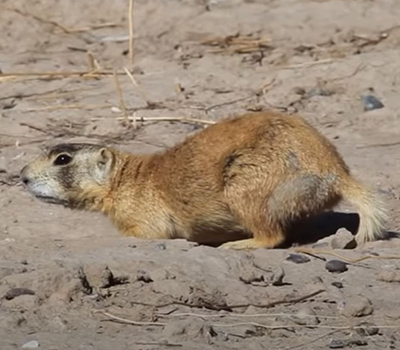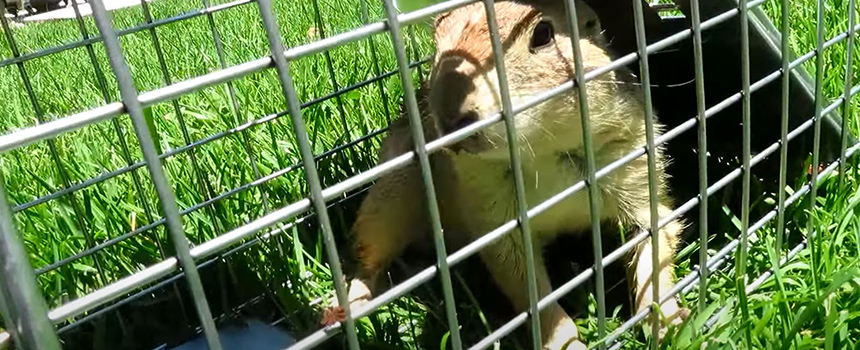- info@wildlifeanimalcontrol.com
Call us for help in your town
Wildlife Control Education
How to Get Rid of Prairie Dogs
 Problems Caused by Prairie Dogs: Prairie dogs tend to avoid confrontations which means that they are very unlikely to cause any physical harm to a person or another animal. Note that they are still wild creatures, and rodents at that, so you must always exercise caution when encountering one. You must never interact with their feces as it can be extremely toxic to humans. Likewise, you should avoid touching the animal to prevent scratches or bites. They can also carry diseases which is why they're best avoided in most situations. Following these precautions is essential to preventing harm from animal contact no matter the kind.
As for specific problems related to prairie dogs themselves, there's mainly one big issue. Due to their obsession with removing vegetation, they can be an extremely harmful species to people like farmers whose entire livelihood relies on their crops. Prairie dogs will tear down as much vegetation as possible to keep themselves and their towns safe from predators. They'll destroy as much clutter as possible to get a clear line of sight towards their immediate environment. They can also do this in smaller settings such as lawn gardens. And they can of course eat any vegetables they find, adding to their destructive rampage; worsened further by just how many of them there can be in an area. Needless to say, prairie dogs can be compared to a swarm of locusts when raiding their local ecosystems. This makes them dangerous pests in the eyes of many people working in fields.
Problems Caused by Prairie Dogs: Prairie dogs tend to avoid confrontations which means that they are very unlikely to cause any physical harm to a person or another animal. Note that they are still wild creatures, and rodents at that, so you must always exercise caution when encountering one. You must never interact with their feces as it can be extremely toxic to humans. Likewise, you should avoid touching the animal to prevent scratches or bites. They can also carry diseases which is why they're best avoided in most situations. Following these precautions is essential to preventing harm from animal contact no matter the kind.
As for specific problems related to prairie dogs themselves, there's mainly one big issue. Due to their obsession with removing vegetation, they can be an extremely harmful species to people like farmers whose entire livelihood relies on their crops. Prairie dogs will tear down as much vegetation as possible to keep themselves and their towns safe from predators. They'll destroy as much clutter as possible to get a clear line of sight towards their immediate environment. They can also do this in smaller settings such as lawn gardens. And they can of course eat any vegetables they find, adding to their destructive rampage; worsened further by just how many of them there can be in an area. Needless to say, prairie dogs can be compared to a swarm of locusts when raiding their local ecosystems. This makes them dangerous pests in the eyes of many people working in fields.
6 Different Ways to Get Rid of Prairie Dogs
Prairie dogs can be a nuisance if you want to keep your garden or farm intact and safe from all the different types of pests out there. The biggest problem with prairie dogs is that they love to munch on anything they can find along with destroying vegetation they don't actually intend to eat. The reason they do this is because they mainly rely on vision to spot predators rather than hiding or fighting. They want to make sure they can see all around them so they can escape without harm. While this is great for keeping them alive it can obviously cause problems when your entire work revolves around thick fields of tall vegetation. Not to mention the constant digging they also love to do.
Read on to learn all about the different methods to keep these small critters under control.

Landscape Modification:
As mentioned above, the main problem comes from their desire to keep the fields around them as trimmed and clutter-free as possible. While there's not much you can do about your tall vegetation if that's what your work relies on, you can instead use artificial means for keeping prairie dogs under control. If you use barriers such as small fences and place them around your field or garden, then the prairie dogs will be much more hesitant to set up a colony there due to the poor visibility. Blocking lines of sight can make it very inconvenient and thus unlikely for these types of animals to want to live there. Do note that you have to be careful and only create thoughtful barriers and not random clutter. Throwing stuff around won't help and will instead encourage other types of animals to want to use them as cover, like rats for example. Rodents like places to hide in so you need to make sure you can balance out the opposing needs of these animals. Create barriers but keep things clean!
Traps:
Traps are unfortunately not a properly reliable method of prairie dog control as they are simply too fast, cautious, and numerous to suffer any real effect from them. Prairie dogs tend to stay outside so you can't just trap them in your house like a rat and unfortunately there can be just as many if not more of them. Running around and trapping up an entire lawn and field might be a bit inconvenient and you can only catch a few of them at a time. They reproduce really rapidly so it's going to end up costing a lot of money just to get a tiny fraction of them. This is not recommended under most circumstances.
Fences:
We discussed fences earlier but do note that they are primarily used for blocking lines of sight. Prairie dogs can still easily burrow under them so to prevent that from happening you would need special types of materials such as hardware cloth. The best way to do it would be to place it around important vegetation that you wish to protect. Simply bury it around 20 inches deep to discourage any prairie dog activity around it.
Poison:
Poisons are also an ineffective way of dealing with prairie dogs for many of the same reasons as traps. There's just too many of them to handle in this way and you also cannot just cover an entire field with poisoned traps or food. You're more likely to forget where you placed them and end up with an area filled with scattered prairie dog corpses. This will just attract worse animals while causing health problems. Not to mention the odor.
Natural Predators:
Definitely off the beaten path but you could attempt to build artificial nesting sites and perches near where the prairie dogs are living as raptors will hunt and scare them off.
Tolerance:
This last option is pretty unique among all the different types of ways to repel a nuisance animal. And that is to simply leave the animals alone and ignore them. Granted this varies by circumstance but there are definitely a few benefits to having prairie dogs around that can actually help you out in the long run. For one, their digging around can actually make the soil more fertile and allows some seeds to grow better. They're also mostly harmless and will keep to themselves. As with any wild animal though you should still never let one bite you nor should you ever come in close contact with them or their feces. But aside from that, they won't really attack anyone and their presence and activities tend to make a few cattle animals be more at peace in their environment. Again this depends on the situation but if you find that getting rid of them is more trouble than it's worth then you can easily just leave them be.
Prairie Dog Biology
Prairie dogs are small rodents that are similar to gophers and the two are often confused. Typically living in North America, they are known for their cute appearance and somewhat pest like behavior. Prairie dogs, like many other rodents, are burrowers who love to dig out tunnels to live in and store their food for the winter. Prairie dogs are very social animals even going as far as allowing other animals to live temporarily inside their burrows. A colony of prairie dogs is referred to as a “town”, with each town being able to host hundreds or even thousands of dogs. Their large numbers can easily be overwhelming to deal with if their presence is posing any sort of problem to you or your property. Prairie dogs are very kind-spirited animals who try to stay away from confrontation and are generally very friendly to others in their family group. They're active mainly during the day and spend their time foraging and eating plants like roots, grass, or seeds. They also have robust methods of communication through their loud cries that signal each other of potential dangers. They can also let each other know when any immediate threat is over so they may resume their usual activities undisturbed. They also keep themselves safe from predators by clearing out as much vegetation as possible around them to prevent other animals from hiding in tall grass or plants. Otherwise, they are very calm and generally try to stay away from humans.

















